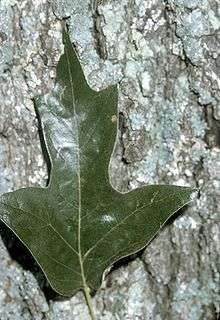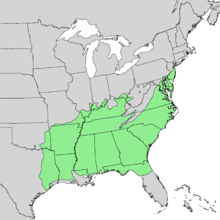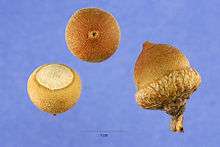Quercus falcata
Quercus falcata, commonly known as the southern red oak or Spanish oak, is a tree in the red oak section (Lobatae) of the genus Quercus native to the eastern and south-central United States.
| Southern red oak | |
|---|---|
 | |
| Leaf and bark | |
| Scientific classification | |
| Kingdom: | Plantae |
| Clade: | Tracheophytes |
| Clade: | Angiosperms |
| Clade: | Eudicots |
| Clade: | Rosids |
| Order: | Fagales |
| Family: | Fagaceae |
| Genus: | Quercus |
| Subgenus: | Quercus subg. Quercus |
| Section: | Quercus sect. Lobatae |
| Species: | Q. falcata |
| Binomial name | |
| Quercus falcata | |
 | |
| Synonyms[2] | |
|
List
| |
Range
Quercus falcata occurs on dry or sandy upland sites from southern New York (Long Island) south to central Florida and west to Missouri, Oklahoma, and Texas.[3] In the northeastern portion of its range the species is relatively rare and found almost exclusively along the coast; its highest prevalence is throughout the piedmont region of the Southeast.[4]
Description
Quercus falcata is a medium to large-sized deciduous tree 25–30 meters (82–98 ft) tall, with a few forest grown specimens on highly productive sites reaching 35–44 meters (115–144 ft), with a trunk up to 1.5 meters (5 feet) in diameter, the crown with a broad, round-topped head.
The leaves are 10–30 cm (4–12 in) long and 6–16 cm (2 1⁄4–6 1⁄4 in) wide, with 3 to 5 sharply pointed, often curved, bristle-tipped lobes, the central lobe long and narrow; the small number of long, narrow lobes is diagnostic, readily distinguishing southern red oak from other red oaks. The base of the leaf is distinctly rounded into an inverted bell shape and often lopsided. They are dark green and shiny above, and rusty and hairy below, particularly along the midrib and veins.

The seed is a short acorn 9–16 mm (11⁄32–5⁄8 in) long, bright orange-brown, enclosed for one-third to half of its length in a flat cup. The acorn matures at the end of its second season. The bark is dark brownish gray with narrow, shallow ridges.[5]
Southern red oak has been reported to form occasional hybrids with several other red oaks in the region. the southern red oak is cultivated in eastern United States in USDA Zone 5a to USDA Zone 9b can survive lows from -23°c to -28.8 °C (-10°f to -20 °F) and highs of 38° C (100° F)
[6]==Famous specimens==
Queen Anne’s County Oak – A southern red oak on record as the largest southern red oak in Queen Anne's County, Maryland. The oak was located on Romancoke Road. It fell on July 23, 2017 due to a tornado. The tree was at least 200 years old, stood 66 feet (20 m) tall, and had a 102.5-foot (31.2 m) spread.[7]
References
- Wenzell , K.; Kenny, L. (2015). "Quercus falcata". IUCN Red List of Threatened Species. 2015: e.T194127A2301887. doi:10.2305/IUCN.UK.2015-4.RLTS.T194127A2301887.en. Retrieved 11 April 2020.
- "Quercus falcata". World Checklist of Selected Plant Families (WCSP). Royal Botanic Gardens, Kew – via The Plant List.
- "Quercus falcata". County-level distribution map from the North American Plant Atlas (NAPA). Biota of North America Program (BONAP). 2014.
- Belanger, Roger P.; Krinard, R. M. (1990). "Quercus falcata". In Burns, Russell M.; Honkala, Barbara H. (eds.). Hardwoods. Silvics of North America. Washington, D.C.: United States Forest Service (USFS), United States Department of Agriculture (USDA). 2. Retrieved July 5, 2011 – via Southern Research Station (www.srs.fs.fed.us).
- Nixon, Kevin C. (1997). "Quercus falcata". In Flora of North America Editorial Committee (ed.). Flora of North America North of Mexico (FNA). 3. New York and Oxford – via eFloras.org, Missouri Botanical Garden, St. Louis, MO & Harvard University Herbaria, Cambridge, MA.
- https://treesdb.azurewebsites.net/Browse/Trees/127925/Details
- Richman, Talia; Davis, Phil; Dance, Scott (July 24, 2017). "'It's devastating': Tornado causes extensive damage on Kent Island". Baltimore Sun. Retrieved July 25, 2017.
External links
![]()
